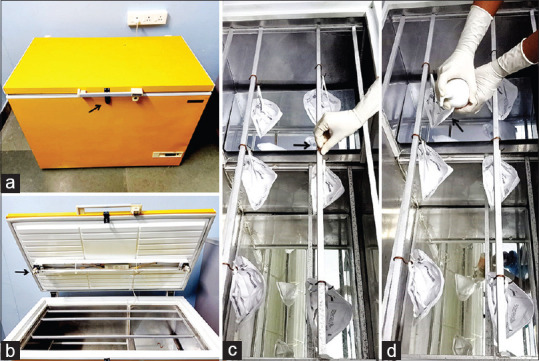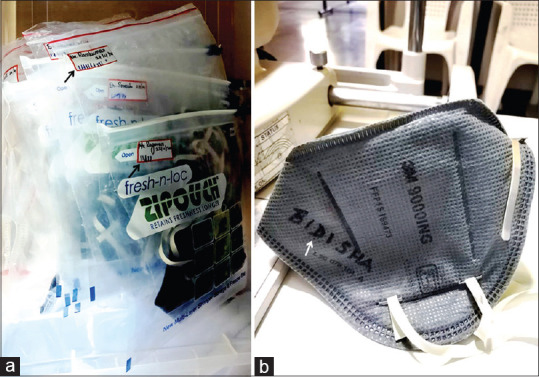Dear Editor:
As we all know, due to the growing coronavirus pandemic the daily demand and utilization of personnel protective equipment's (PPE) have increased exponentially. Moreover, this has also resulted in acute shortage of PPE.[1] The need of the hour is to minimize this shortage by decontaminating these respirators, so that they can be optimally reused. We already have evidence for Ultraviolet light and Hydrogen Peroxide (H2O2) as a good source for decontamination of PPE.[2] Hence, we implemented an innovative idea of decontamination of the respirators by using old condemned air tight freezer boxes [Fig. 1a] which are installed with Ultraviolet C (UV-C 254 nm, 60 mJ/cm2) tube lights [Fig. 1b].[2]
Figure 1.

(a) Image of the old condemned airtight freezer box. An additional lock (black arrow) is provided as a safety feature. (b) Image of the freezer box with open lid depicting installed UV-C light (254 nm- black arrow) for decontamination of respirators. (c) Image of the open freezer box depicting how respirators are attached with the help of copper hangers (black arrow). Additionally the mirrors can be seen on the base and the walls of the box for reflecting UV-C light. (d) Image depicting how hydrogen peroxide is sprayed over the respirators (black arrow) before switching on the freezer box
The respirators are placed in the freezer box with the help of copper hangers [Fig. 1c] and H2O2 is sprayed over the respirators [Fig. 1d].[3,4] The freezer box also has mirrors on walls and the base to reflect the light [Fig. 1c]. This increases the efficiency of decontamination and prevent the need for flipping the respirators. When UV-C light comes in contact with H2O2, free hydroxyl radicals are generated by advance oxidation process. These free radicals further destroy the germs, viruses, and microbes over the surface.[3] The recommended cycle for decontamination is 15–20 minutes.[5] An automatic safety feature is included in the freezer box. The light gets switched off once the box is opened and automatically gets switched on once the box is closed, to prevent health hazards to the operator.
Once the respirators are decontaminated, they are kept in sterilized zip lock bags, which can be used whenever needed. The respirators and the zip lock bags are tagged with the name of the health care worker, so as to avoid confusion [Fig. 2a and b]. These respirators can be effectively decontaminated for 5 cycles[5] in this chamber. We recommend this economical technique of PPE decontamination, in health care facilities to combat the COVID-19 pandemic.
Figure 2.

(a) Image depicting sterilized zip lock bags with decontaminated respirators within. The zip lock bags have the name of the health care workers marked so as to avoid confusion (black arrow) (b) Image of the respirator depicting the name of the doctor (black arrow)
Financial support and sponsorship
Nil.
Conflicts of interest
There are no conflicts of interest.
Acknowledgements
Aravind Eye Hospital and Post Graduate Institute of Ophthalmology, Pondicherry.
References
- 1.Boskoski I, Gallo C, Wallace MB, Costamagna G. COVID-19 pandemic and personal protective equipment shortage: Protective efficacy comparing masks and scientific methods for respirator reuse. Gastrointest Endosc. 2020 doi: 10.1016/j.gie.2020.04.048. S0016-5107(20)34247-4 doi: 101016/jgie202004048. [DOI] [PMC free article] [PubMed] [Google Scholar]
- 2.Mills D, Harnish DA, Lawrence C, Sandoval-Powers M, Heimbuch BK. Ultraviolet germicidal irradiation of influenza-contaminated N95 filtering facepiece respirators. Am J Infect Control. 2018;46:e49–e55. doi: 10.1016/j.ajic.2018.02.018. [DOI] [PMC free article] [PubMed] [Google Scholar]
- 3.Schwartz A, Stiegel M, Greeson N, Vogel A, Thomann W, Brown M, et al. Decontamination and reuse of N95 respirators with hydrogen peroxide vapor to address worldwide personal protective equipment shortages during the SARS-CoV-2 (COVID-19) pandemic. Appl Biosafety. 2020 doi: 10.1177/1535676020919932. doi: 101177/1535676020919932. [DOI] [PMC free article] [PubMed] [Google Scholar]
- 4.Lore MB, Heimbuch BK, Brown TL, Wander JD, Hinrichs SH. Effectiven of three decontamination treatments against influenza virus applied to filtering facepiece respirators. Ann Occup Hyg. 2012;56:92–101. doi: 10.1093/annhyg/mer054. [DOI] [PubMed] [Google Scholar]
- 5.Kyle J, Card JK, Crozier D, Dhawan A, Dinh M, Dolson E, Farrokhian N, et al. UV Sterilization of personal protective equipment with idle laboratory biosafety cabinets during the COVID-19 pandemic. medRxiv. 2020 doi: 10.1371/journal.pone.0241734. [DOI] [PMC free article] [PubMed] [Google Scholar]


